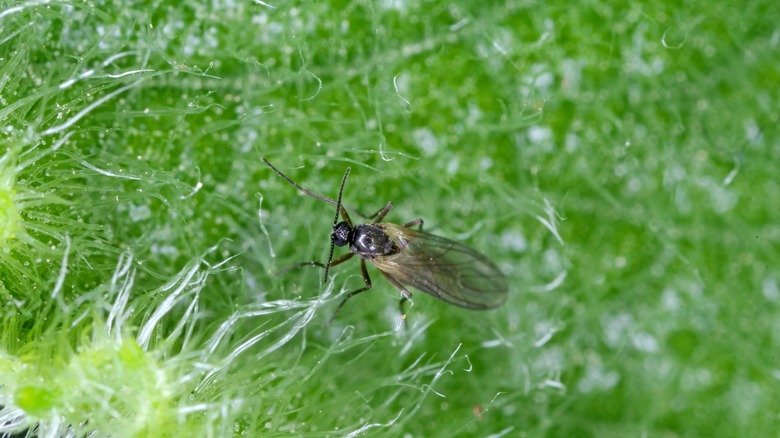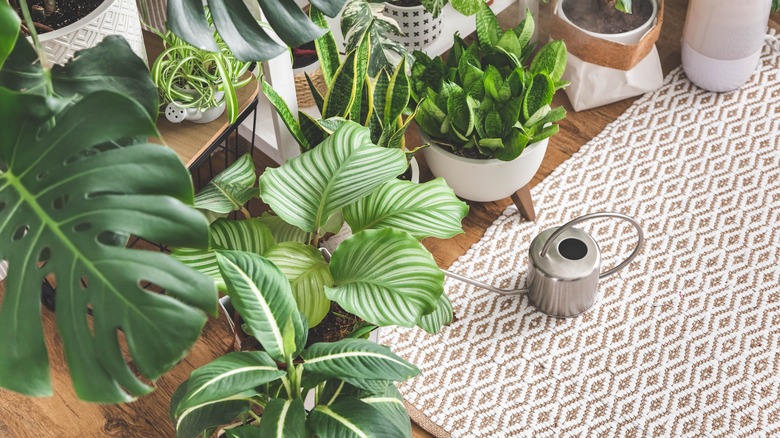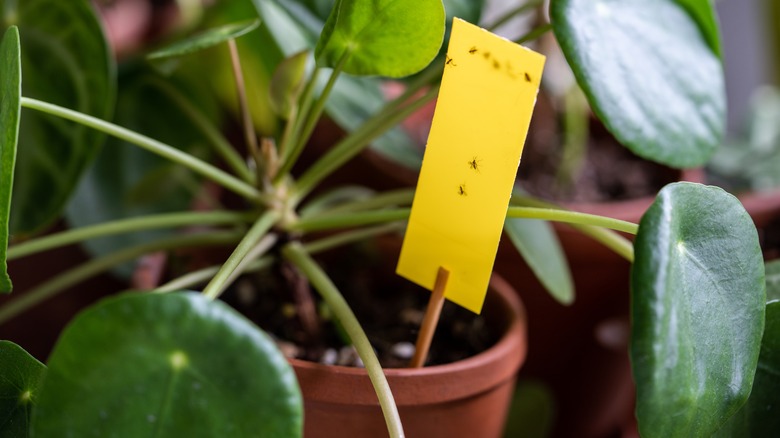Try This Simple Soil Trick To Get Rid Of Gnats In Your Plants Naturally
So you've created your very own perfectly lush plant oasis in your home, full of colorful houseplants in their carefully chosen pots — and here come the gnats. Gnats are a common pest — one that every plant lover is bound to deal with sooner or later. To a gnat, your beloved houseplants are a perfect nesting site, as they like to lay their eggs in damp soil. That means there's also one simple way to keep gnats away from plants: keep your soil dry.
The tiny black bugs on your plants aren't fruit flies, but another species called fungus gnats. Aside from being annoying, fungus gnats can also pose risks to your plants if the infestation gets out of hand. The larvae feed on fungi in the soil, decaying plant matter, and plant roots. "Fungus gnats in small amounts aren't a big deal," Lisa Eldred Steinkopf, the Houseplant Guru and author of "Houseplants: The Complete Guide to Choosing, Growing, and Caring for Indoor Plants," exclusively told HouseDigest. "In severe cases, where many gnats are present, the larvae could cause excessive damage to the roots. Fungus gnats can also spread disease, so it is imperative to get rid of them."
Thankfully, a simple change to your watering routine can help. If you keep the top of your soil dryer, the gnats will find somewhere else to lay their eggs. Here's how to tell you have a fungus gnat infestation and how to change your watering practices to get rid of them.
Fungus gnat warning signs, and how dry to keep the soil
Once you see fungus gnats flying around your plants, face, and home, "you know there are larvae in your soil," Steinkopf exclusively explained to House Digest. The larvae, rather than the flying adults, are the culprit of potential damage to your plants. "They are in your potting mix, snacking on your roots," she stated. Signs of a large number of gnat larvae include yellowing leaves and plant collapse.
By allowing the top layer of soil to dry out fully, you can prevent fungus gnat infestations from taking root in the first place. It's also important to remove any dead plant material before it decays. "They prefer moist potting mix and decaying plant material, so if isn't present they won't be either," Steinkopf said. "Let the mix dry down at least a couple of inches to prevent larvae from taking up residence." You can simply stick your finger in to check how dry the soil is, or pay attention to how light or dark it appears, as soil darkens when wet.
Steinkopf says that reducing water is particularly effective at keeping fungus gnat numbers down if the infestation is minimal, or as a preventative method. "I may have a few gnats now and then, but I am more likely to keep my plants dry than wet, and so find I don't have a problem," she said.
Downsides of dry soil and other prevention methods
Water is key to plant growth, and some species do prefer moist soil. So this trick should be used with care and discernment. "There is a fine line between being too dry and too wet for plants," Steinkopf told House Digest in an exclusive interview. "If you are trying to keep your plants a bit drier, it would be easy to take it too far," she warned. You could also consider using watering bulbs, which will water directly and deeply into the plant and help keep the first few inches relatively dry. However, this won't work with all types of plants.
There are other ways to get rid of fungus gnats aside from keeping the soil dry. Steinkopf recommends using yellow sticky traps to capture adults flying around, which will prevent them from laying eggs and stop the cycle. You can also add granular microbial insecticide to the potting mix, following the directions on the label — they're effective against gnat larvae in addition to mosquitos. Lastly, she says you can replace the top 1 to 2 inches of potting mix (which is where the larvae live and feed) with fresh, uninfested soil.


